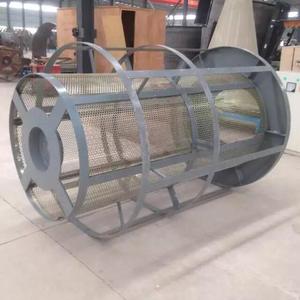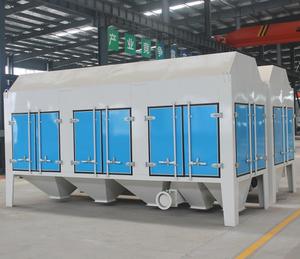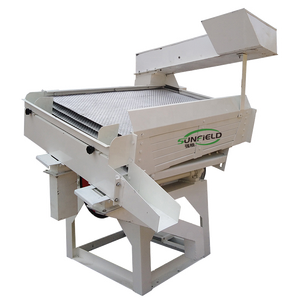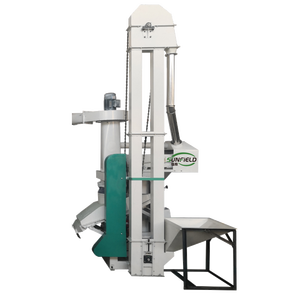(2592 products available)











































































































































































































































Separators come in various models according to the function, technology for separating paddies and rice, and the agriculture industry. Here are some of them:
Gravity Separator:
A paddy grain separator machine based on the force of gravity comes under this category. Such machines classify food grains into distinct groups based on their mass and sizes. It works by letting the grains free fall through a slanted deck after which they get stratified into different layers based on the mentioned characteristics. The layers then get collected separately. This type of grain separator is widely used in rice mills.
Husk Separator:
In the primary rice milling process, rice huller separators play a critical role. They separate the rice from its husk or shell. The device works by hull friction against a screen after which the rice escapes through the screen while the hulls remain trapped. After this the rice get processed further, it can then be separated into different categories according to quality, shape, size, color, etc.
Indents Separator:
Indents rice separators are designed to classify grains based on their lengths and sizes. The separator machine has indent cylinders which are rotated at a high speed. The shorter grains get caught up in the indentations while the longer ones fall off. This type of separator is commonly used in rice mills where only long-grain rice is desired.
Optical Separator:
The modern electronic separators are based on optical imaging and are camera-controlled. They recognize and separate abnormal or discolored grains by a predetermined colour or shape. Such grains may include damaged rice, weed seeds, straw, wild oats, or other foreign materials. Optical rice separators offer a high degree of accuracy and can process large quantities of rice quickly. However, they typically are more costly than other kinds of separators.
Vibro Separator:
A vibro separator rice is a device that uses vibration to distinguish between different types of rice and foreign substances. With the help of its vibrating deck and air blasts, the separator is able to agitate rice grains of various shapes and sizes and blow away the foreign ones. Vibro separators are frequently used in rice milling factories along with other types of separators to achieve more efficient rice processing and cleaning.
The application of seed paddy separators is vast, especially in the rice production and processing industries.
When buying a seed paddy separator machine, it is important to choose the right capacity and performance that matches the needs of the farm or business. Walk-behind paddy separators are usually suitable for small farms that process about 200 to 1,000 kg/hour. On average, small to medium separator machines have a processing capacity of 1,200 - 1,600 kg/hour. Such machines are convenient for regions that produce a huge quantity of rice and paddy seed. For large-scale rice processing businesses with an annual processing volume of over 10 tons, a high-capacity separator machine of 3,000 kg/hour or more is appropriate. Additionally, confirm if the machine is fully automatic, semi-automatic, or manual and select one that suits the requirements well.
Consider the efficiency of the separator machine. It should have a high level of separation efficiency, usually over 95 percent, to minimize impurities in the rice. The separating accuracy should also be high, with only a small percentage of dried, cracked, and damaged grains passing through. The energy consumption of the machine is also important. Choose a machine that uses the least energy to minimize operating costs. Inspect the separator machine carefully, making sure it is strong and well-made. Look at its construction materials, and check for any signs of wear or damage. The moving parts, such as bearings, belts, and blocks, should all be in good condition to ensure smooth operation. The settings on the machine should be easy to adjust for different types of rice.
It's important to get a separator machine that is easy to maintain. Routine maintenance helps keep the machine running properly for a long time. The operator manual should be available so that maintenance and repair services can be done easily. It’s also a good idea to get a separator with locally available spare parts to help reduce downtime in case repairs are needed. Finally, buyer should also consider the costs to set up the seed paddy separator machine. If possible, get quotes from different suppliers and compare prices. Look at the total costs, including installation, training, and maintenance fees, and choose a machine that offers great value for money.
Q1: How does a seed paddy separator work?
A1: Seed paddy separators work by passing rice seeds through a vibratory screen. The vibratory screen has different hole sizes that allow smaller objects to fall through while larger ones stay on top. The larger objects are collected on top and ejected further down the process while the smaller objects are collected below.
Q2: How automated are seed paddy separators?
A2: Many seed paddy separators are automated so that the vibratory screen can be changed with the push of a button. However, some manual intervention is needed to feed the separator input and collect the output. The amount of automation will depend on the specific model.
Q3: What are the main types of seed paddy separators?
A3: Separators can be broadly classified into air, water, and screen separators. Screen separators are the most commonly used type. Within the category of screen separators, they can further be divided into flat and concave screens. Gravity separators are fixed tilted flat screens that separate rice seeds based on size and density difference. Screen-Keyboard组合 refers to an electromagnetic separation method that uses both screen and keyboard to differentiate between rice seed varieties.
Q4: What are the main advantages of using a seed paddy separator?
A4: Seed paddy separators have the ability to improve rice yield by reducing the amount of undesirable seeds in the final product. They can offer a high degree of separation accuracy, helping to separate seeds that are of similar shape and size. Seed paddy separators can also reduce the dependence on manual separation, which can be time-consuming and tedious.
Q5: What is the maximum capacity of a seed paddy separator?
A5: The capacity of seed paddy separators varies according to the model chosen. Large industrial-scale separators can process up to 500-700 kgs per hour. Smaller models used for more small-scale operations can handle 20-100 kgs per hour. Separators with a larger capacity tend to be more expensive.